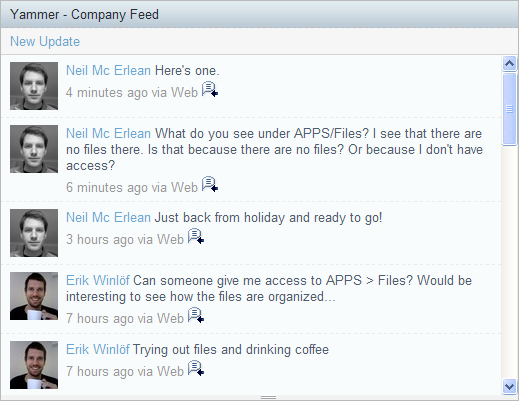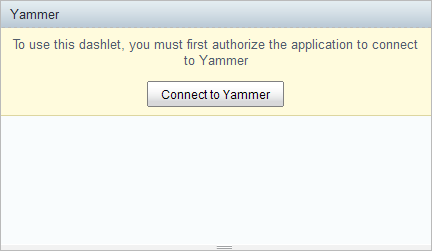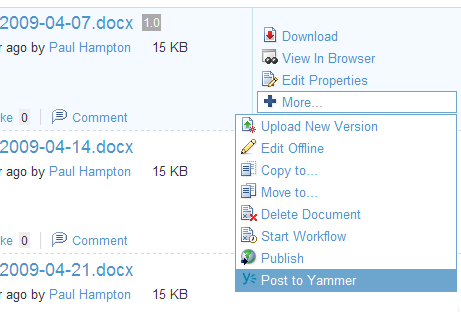Author: Will Abson
This project provides a custom dashlet to display messages from the Yammer social network and allows the user to reply to existing messages and compose new messages.

Since Yammer requires all communications to be authenticated, the dashlet provides an easy method for you to connect it to your Yammer account.

In addition a custom Document Library action can be used to post a link to the document directly to Yammer, if you have already connected using the dashlet.

Note that the Yammer dashlet requires Alfresco 4.0 or greater, or a 3.4 installation with v1.0 Final Spring Surf libraries, and you must also install the Share OAuth add-on. The custom action will work with Alfreso 4.0 only
The dashlet is packaged as a single JAR file for easy installation into Alfresco Share.
To install the dashlet, simply drop the yammer-dashlet-<version>.jar file into the tomcat/shared/lib folder within your Alfresco installation, and restart the application server. You might need to create this folder if it does not already exist.
The custom Post to Yammer action is supported on Alfresco 4.0 and above. You can enable it on both the document details and document list pages by adding the following configuration to your share-config-custom.xml.
<config evaluator="string-compare" condition="DocLibActions">
<actionGroups>
<actionGroup id="document-browse">
<action index="999" id="document-yammer-post" />
</actionGroup>
<actionGroup id="document-details">
<action index="999" id="document-yammer-post" />
</actionGroup>
</actionGroups>
</config>
An Ant build script is provided to build a JAR file containing the custom files, which can then be installed into the tomcat/shared/lib folder of your Alfresco installation.
To build the JAR file, run Ant from the base project directory.
ant dist-jar
The command should build a JAR file named yammer-dashlet-<version>.jar in the build/dist directory within your project, which you can then copy into the tomcat/shared/lib folder of your Alfresco installation.
Alternatively, you can use the build script to hot deploy the JAR file directly into a local Tomcat instance for testing. You will need to use the hotcopy-tomcat-jar task and set the tomcat.home
property in Ant.
ant -Dtomcat.home=C:/Alfresco/tomcat hotcopy-tomcat-jar
After you have deployed the JAR file you will need to restart Tomcat to ensure it picks up the changes.
As of Nov 11 it has not been possible to register Share Extras with Yammer as a global application, and it is currently limited to the Yammer Developers and Alfresco networks.
The workaround is to register your own Yammer application, which will give you a client token and secret that you can then use with your own network.
To configure these parameters, add the following to your share-config-custom.xml
<config evaluator="string-compare" condition="Remote">
<remote>
<!-- Connector instance -->
<connector>
<id>yammer-oauth</id>
<name>Yammer OAuth Connector</name>
<description>HTTP Connector with support for OAuth authentication</description>
<class>org.sharextras.webscripts.connector.HttpOAuthConnector</class>
<consumer-key>mykey</consumer-key>
<consumer-secret>mysecret</consumer-secret>
<signature-method>PLAINTEXT</signature-method>
</connector>
</remote>
</config>
where mykey is the client token and mysecret is the client secret for the application you registered.
